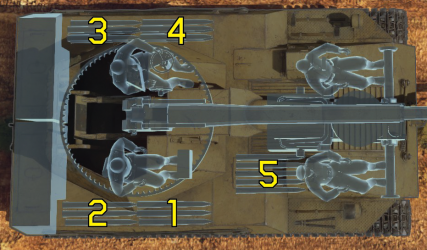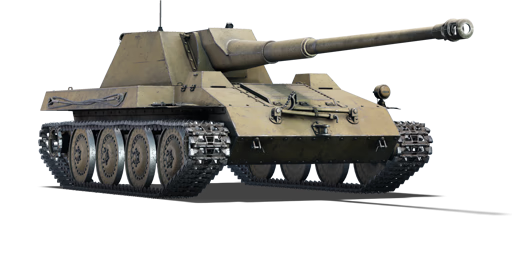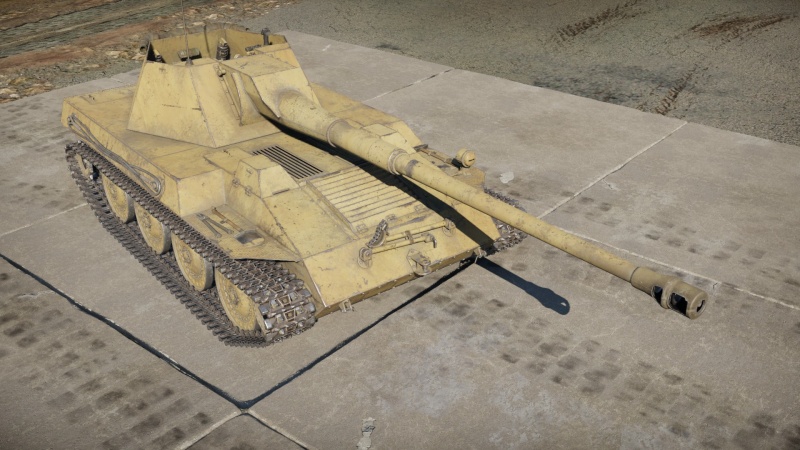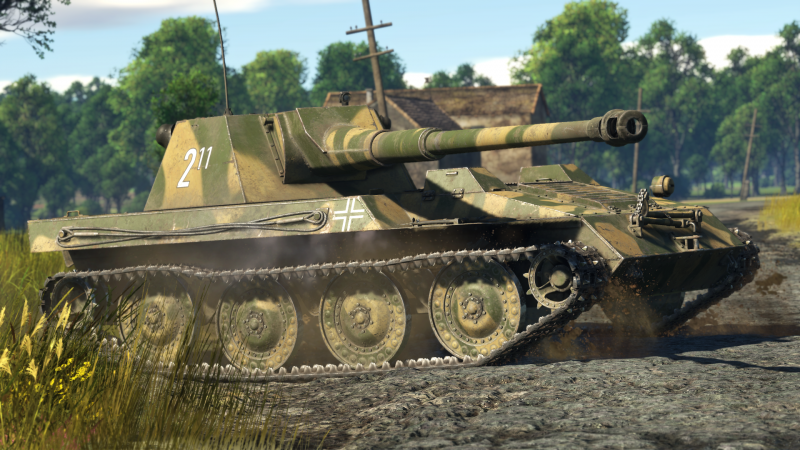Difference between revisions of "Waffentrager"
Colok76286 (talk | contribs) (Edits) |
m (added a small amount of tet to the survivability section) (Tag: Visual edit) |
||
| Line 14: | Line 14: | ||
{{Specs-Tank-Armour}} | {{Specs-Tank-Armour}} | ||
<!-- ''Describe armour protection. Note the most well protected and key weak areas. Appreciate the layout of modules as well as the number and location of crew members. Is the level of armour protection sufficient, is the placement of modules helpful for survival in combat? If necessary use a visual template to indicate the most secure and weak zones of the armour.'' --> | <!-- ''Describe armour protection. Note the most well protected and key weak areas. Appreciate the layout of modules as well as the number and location of crew members. Is the level of armour protection sufficient, is the placement of modules helpful for survival in combat? If necessary use a visual template to indicate the most secure and weak zones of the armour.'' --> | ||
| − | The Waffenträger is extremely vulnerable in a combat zone due to its extremely weak armour and open-topped design. Even if the thin armour may not set off the fuse of enemy shells, the extensive placement of ammunition around the tank frequently results in explosions if the crew compartment at the back of the tank is penetrated. Furthermore, any | + | The Waffenträger is extremely vulnerable in a combat zone due to its extremely weak armour and open-topped design. Even if the thin armour may not set off the fuse of enemy shells, the extensive placement of ammunition around the tank frequently results in explosions if the crew compartment at the back of the tank is penetrated. Furthermore, any planes that spot the Waffenträger will not hesitate to strafe it (especially if they have been a victim of its long 88), resulting in the vehicle's destruction. Remember that Waffenträger can be easily damaged by nearby explosions from bombs or artillery; always move or change position whenever you notice planes heading your way or an enemy artillery alert is displayed. |
'''Armour type:''' | '''Armour type:''' | ||
Revision as of 10:40, 22 March 2024
Contents
Description
The Waffenträger Krupp-Steyr mit Pak 43 is a rank III German tank destroyer with a battle rating of 5.7 (AB/RB/SB). It was introduced in Update 1.71 "New E.R.A.". Waffenträger translates to "weapon carrier" in English.
The Waffenträger 88 mm PaK 43/3 is a German prototype tank destroyer from World War II. With its default yellow camouflage, low profile, and 88 mm cannon, the Waffenträger is a versatile tank destroyer that can play many roles and offer new playstyles that are not possible with conventional turretless German tank destroyers. The vehicle had a single 88 mm PaK43/3 gun and no secondary armament. It was assumed from the start that the new tank destroyer would be as simple in construction and design as possible, that the crew compartment would only be marginally protected, and that the vehicle would enter production as soon as possible.
General info
Survivability and armour
The Waffenträger is extremely vulnerable in a combat zone due to its extremely weak armour and open-topped design. Even if the thin armour may not set off the fuse of enemy shells, the extensive placement of ammunition around the tank frequently results in explosions if the crew compartment at the back of the tank is penetrated. Furthermore, any planes that spot the Waffenträger will not hesitate to strafe it (especially if they have been a victim of its long 88), resulting in the vehicle's destruction. Remember that Waffenträger can be easily damaged by nearby explosions from bombs or artillery; always move or change position whenever you notice planes heading your way or an enemy artillery alert is displayed.
Armour type:
- Rolled homogeneous armour
| Armour | Front (Slope angle) | Sides | Rear | Roof |
|---|---|---|---|---|
| Hull | 10 mm (76°), 20 mm (46°) Front glacis 5 mm (46°) Engine grille 20 mm (44°) Lower glacis 10 mm (46°) Crew ports |
10 mm (25°) Top 10 mm Bottom |
10 mm (26°) Top 10 mm (15°) Bottom |
5 mm |
| Turret | 20 mm (41°) Turret front 20 mm (5-46°) Gun mantlet |
10 mm (22-24°) | 10 mm (24°) | N/A |
Notes:
- Suspension wheels are 20 mm thick, and tracks are 30 mm thick.
- Belly armour is 5 mm thick.
- A 10 mm structural steel plate covers the engine from the crew.
Mobility
The Waffenträger's mobility is suboptimal, and it frequently fails to react quickly enough to the sudden appearance of enemy tanks in close combat. Due to its slow turret traverse speed and slow top speed, it can be difficult to reach advantageous positions ahead of time against enemy light tanks at the start of the match. This, combined with the fact that the engine is located in front of the tank, makes it easy for enemy gunfire to disable the vehicle. To maximise your reaction time, always plan your route ahead of time and keep some distance between yourself and the main combat zone.
| Game Mode | Max Speed (km/h) | Weight (tons) | Engine power (horsepower) | Power-to-weight ratio (hp/ton) | |||
|---|---|---|---|---|---|---|---|
| Forward | Reverse | Stock | Upgraded | Stock | Upgraded | ||
| Arcade | 38 | 8 | 16.3 | 199 | 267 | 12.21 | 16.38 |
| Realistic | 35 | 7 | 124 | 140 | 7.61 | 8.59 | |
Modifications and economy
After the Parts and FPE modifications, the most useful upgrades are the Horizontal Drive, Adjustment of Fire, and Mobility modules.
Armaments
Main armament
| 88 mm PaK43 | Turret rotation speed (°/s) | Reloading rate (seconds) | |||||||||||
|---|---|---|---|---|---|---|---|---|---|---|---|---|---|
| Mode | Capacity | Vertical | Horizontal | Stabilizer | Stock | Upgraded | Full | Expert | Aced | Stock | Full | Expert | Aced |
| Arcade | 30 | -8°/+45° | ±180° | N/A | 12.3 | 17.1 | 20.7 | 22.9 | 24.4 | 11.05 | 9.78 | 9.01 | 8.50 |
| Realistic | 8.3 | 9.8 | 11.9 | 13.2 | 14.0 | ||||||||
Ammunition
| Penetration statistics | |||||||
|---|---|---|---|---|---|---|---|
| Ammunition | Type of warhead |
Penetration @ 0° Angle of Attack (mm) | |||||
| 10 m | 100 m | 500 m | 1,000 m | 1,500 m | 2,000 m | ||
| PzGr 39/43 | APCBC | 237 | 234 | 222 | 207 | 193 | 180 |
| PzGr 40/43 | APCR | 279 | 273 | 252 | 227 | 205 | 185 |
| Hl.Gr 39 | HEAT | 110 | 110 | 110 | 110 | 110 | 110 |
| Sprgr.43 | HE | 19 | 19 | 17 | 16 | 14 | 14 |
| Shell details | ||||||||||||
|---|---|---|---|---|---|---|---|---|---|---|---|---|
| Ammunition | Type of warhead |
Velocity (m/s) |
Projectile mass (kg) |
Fuse delay (m) |
Fuse sensitivity (mm) |
Explosive mass (TNT equivalent) (g) |
Ricochet | |||||
| 0% | 50% | 100% | ||||||||||
| PzGr 39/43 | APCBC | 1,000 | 10.16 | 1.2 | 14 | 108.8 | 48° | 63° | 71° | |||
| PzGr 40/43 | APCR | 1,130 | 7.3 | - | - | - | 66° | 70° | 72° | |||
| Hl.Gr 39 | HEAT | 600 | 7.64 | 0 | 0.3 | 1,100 | 62° | 69° | 73° | |||
| Sprgr.43 | HE | 820 | 9.4 | 0.2 | 0.1 | 1,000 | 79° | 80° | 81° | |||
Ammo racks

| Full ammo |
1st rack empty |
2nd rack empty |
3rd rack empty |
4th rack empty |
5th rack empty |
Visual discrepancy |
|---|---|---|---|---|---|---|
| 30 | 26 (+4) | 21 (+9) | 16 (+14) | 11 (+19) | 1 (+29) | No |
Notes:
- Shells are modeled individually and disappear after having been shot or loaded.
- Right side empty: 21 (+9) shells.
Usage in battles
Despite its fully-traversable turret, the Waffenträger is a classic tank destroyer. It has a potent gun, which can defeat almost any heavy tank at this tier, even at long ranges. The shells have great penetration, great explosive filler, and above-average velocity for the tier. The vehicle even has a better-than-average reload speed. (Note: keep in mind that the Waffenträger is not equipped with any machine guns.)
However, this vehicle also has poor mobility. It's just slow (both forwards and reverse), especially when stock and acceleration are poor. The tank struggles on slopes and is completely unsuited for close-up brawling. Another downside to this vehicle is its poor armour setup. Although the armour protection can defend against machine-gun fire, any cannon shell will penetrate with ease. High explosive shells may also overpressure the vehicle. And finally, the open-top turret compartment is vulnerable to aircraft and artillery fire. Therefore, it may be necessary to work with SPAA teammates and find cover under trees or behind buildings.
In addition to the poor mobility, the Waffenträger suffers a lack of gun depression when the cannon is pivoted above the radio operator's or driver's hatch, so careful hull placement is required when engaging targets below your slope level. The Waffenträger also suffers a reduced reload rate due to its cramped turret, making the act of reloading the breech with the large shells difficult and awkward.
Given the vehicle's advantages and disadvantages, a good way to play this vehicle is often in a sniping play-style. Staying hidden, keeping distance, and only exposing the vehicle to shoot capitalizes on the strength of the vehicle's gun while minimizing the effects of its weak armour. Additionally, it is effortless to hide this vehicle behind cover in a hull-down position since it has a low profile and good gun depression.
Alternatively, it may also be beneficial to employ a more ambush-based playstyle with this vehicle. But since this requires more close-up engagements, be careful to avoid lengthy brawls, where the Waffenträger's poor armour and mobility will hinder it greatly. Positioning is still critical. Finally, it may be sometimes possible to engage the enemy while orienting the vehicle sideways or backwards. This protects the engine and transmission from enemy fire and prevents the protruding frontal optics ports from interfering with gun traverse and depression.
Pros and cons
Pros:
- 88 mm PaK 43 gun power can destroy any vehicle it meets
- Full rotating turret with the powerful gun
- Decent -8° gun depression for hull-down positions
- Low profile construction makes the vehicle easily conceal
- Suspension and tracks cover a good portion of the lower side hull for protection
- All AP and APHE shells over-pierce the tank without dealing much damage due to the fragile armour
Cons:
- Open-top turret crew vulnerable to shrapnel, machine guns, airstrikes, artillery, and such
- Gun recoil can jump the vehicle dramatically, throwing off the aim and bouncing the vehicle position
- Thin overall armour of between 10-20 mm
- 5 mm roof armour means an aerial attack is deadly
- 5 mm belly armour makes any HE shots able to penetrate through the bottom
- Front-mounted engine and transmission means both can be knocked out with a front shot, immobilizing the vehicle
- Poor acceleration
- Hatches on the front of the tank can disrupt the aim
History
Development
In as early as 1942, the German Wehrmacht was looking for a way to make large anti-tank guns easier to deploy and transport and fire the gun and fight on the front lines. Four major German companies (Krupp, Rheinmetall, Borsig, and Ardelt) took part in a tender of the Waffenamt (German Army Weapons Agency) in 1943 for the project. Then, in April 1944, the four companies presented their prototypes. With Krupp and Steyr working together on a design, and Rheinmetall and Borsig on their own. Both designs envisaged placing the 8.8 cm PaK 43 L / 71 in a lightly armoured, upwardly open, rotatable tower mounted on a hull of a Raupenschlepper Ost (a tracked artillery mover) to keep costs down and reduce complexity. However, the decision was made for the prototype of the last company, Ardelt, therefore making the Krupp-Steyr design unwanted by the Waffenamt.
Combat usage
Due to the design losing the tender, the tank never saw mass production or combat service. Only one wooden model and one prototype were manufactured on September 2, 1944.
Media
- Skins
- Videos
See also
Links to the articles on the War Thunder Wiki that you think will be useful for the reader, for example:
- reference to the series of the vehicles;
- links to approximate analogues of other nations and research trees.
External links
| Germany tank destroyers | |
|---|---|
| Pz. I Derivatives | Panzerjäger I |
| Pz. II Derivatives | 15cm sIG 33 B Sfl |
| Pz. 38(t) Derivatives | Marder III · Marder III H · Jagdpanzer 38(t) |
| Pz. III Derivatives | StuG III A · StuG III F · StuG III G · StuH 42 G |
| Pz. IV Derivatives | Jagdpanzer IV · Panzer IV/70(A) · Panzer IV/70(V) · Dicker Max · Nashorn · Brummbär · VFW |
| Pz. V Derivatives | Jagdpanther G1 · Bfw. Jagdpanther G1 |
| Pz. VI Derivatives | Sturer Emil · Elefant · Ferdinand · 38 cm Sturmmörser · Jagdtiger |
| Wheeled/Half-track | 8,8 cm Flak 37 Sfl. · Sd.Kfz.251/9 · Sd.Kfz.251/10 · Sd.Kfz.251/22 · Sd.Kfz.234/3 · Sd.Kfz.234/4 · 15 cm Pz.W.42 |
| ATGM Carrier | RakJPz 2 · RakJPz 2 (HOT) · Wiesel 1A2 |
| Other | Waffenträger · M109G · JPz 4-5 · Raketenautomat · VT1-2 |






